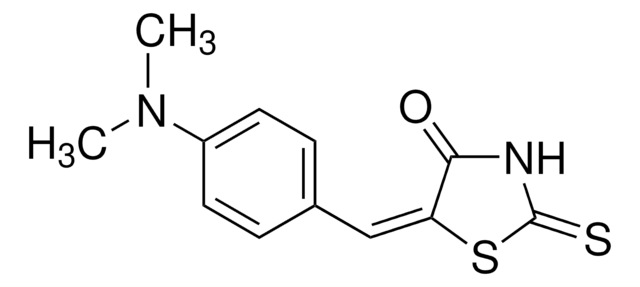1.06048
Diclorometano
for spectroscopy Uvasol®
Sinónimos:
Cloruro de metileno
About This Item
Productos recomendados
vapor density
2.9 (vs air)
Quality Level
vapor pressure
24.45 psi ( 55 °C)
6.83 psi ( 20 °C)
assay
≥99.9% (GC)
form
liquid
autoignition temp.
1223 °F
605 °C (DIN 51794)
potency
1600 mg/kg LD50, oral (Rat)
>2000 mg/kg LD50, skin (Rat)
contains
~50 ppm 2-methyl-2-butene as stabilizer
expl. lim.
22 %
technique(s)
UV/Vis spectroscopy: suitable
impurities
≤0.0002 meq/g Acidity
≤0.0002 meq/g Alkalinity
≤0.01% Water
evapn. residue
≤0.0002%
color
APHA: ≤10
transmittance
235 nm, ≥30%
240 nm, ≥70%
245 nm, ≥85%
250 nm, ≥95%
255 nm, ≥98%
refractive index
n20/D 1.424 (lit.)
pH
7 (20 °C)
bp
39.8-40 °C (lit.)
mp
-95 °C
−95 °C (lit.)
density
1.325 g/mL at 25 °C (lit.)
UV absorption
λ: 235 nm Amax: ≤0.52
λ: 240 nm Amax: ≤0.16
λ: 245 nm Amax: ≤0.07
λ: 250 nm Amax: ≤0.02
λ: 255 nm Amax: ≤0.01
storage temp.
2-30°C
SMILES string
ClCCl
InChI
1S/CH2Cl2/c2-1-3/h1H2
InChI key
YMWUJEATGCHHMB-UHFFFAOYSA-N
¿Está buscando productos similares? Visita Guía de comparación de productos
Categorías relacionadas
General description
Application
- Intra-Species Variations of Bioactive Compounds of Two Dictyota Species from the Adriatic Sea: Antioxidant, Antimicrobial, Dermatological, Dietary, and Neuroprotective Potential.: This study analyzes the bioactive compounds of Dictyota species, detailing their potential uses in various therapeutic areas. It highlights dichloromethane′s role in extracting these compounds, enhancing their analytical characterization and understanding their effects (Martić et al., 2023).
- Production of Two Isomers of Sphaeralcic Acid in Hairy Roots from Sphaeralcea angustifolia.: This research focuses on the production of sphaeralcic acid isomers in hairy root cultures, with a significant mention of dichloromethane used in the extraction processes. The study aids in understanding the compound′s stability and bioactivity, crucial for developing pharmaceutical applications (Barrera et al., 2023).
- Chemical Defense against Herbivory in the Brown Marine Macroalga Padina gymnospora Could Be Attributed to a New Hydrocarbon Compound.: Investigates the chemical defenses of Padina gymnospora against herbivores, with a focus on a new hydrocarbon compound isolated using dichloromethane. This research underscores the importance of solvent choice in the extraction and characterization of marine natural products (Pereira et al., 2023).
- Isolation and Characterization of One New Natural Compound with Other Potential Bioactive Secondary Metabolites from Glycosmis cyanocarpa (Blume) Spreng. (Family: Rutaceae).: Details the isolation of new natural compounds from Glycosmis cyanocarpa, emphasizing the role of dichloromethane in the extraction process. This article provides insights into the potential pharmacological applications of these compounds (Islam et al., 2023).
- Scutellaria petiolata Hemsl. ex Lace & Prain (Lamiaceae).: A New Insight in Biomedical Therapies.: Discusses the biomedical potential of Scutellaria petiolata, highlighting the use of dichloromethane in the extraction of bioactive compounds. This study contributes to the understanding of the therapeutic applications of the plant′s extracts (Mubin et al., 2022).
Analysis Note
Evaporation residue: ≤ 0.0002 %
Water: ≤ 0.01 %
Color: ≤ 10 Hazen
Acidity: ≤ 0.0002 meq/g
Alkalinity: ≤ 0.0002 meq/g
Fluorescence (as quinine at 254 nm): ≤ 1.0 ppb
Fluorescence (as quinine at 365 nm): ≤ 1.0 ppb
Transmission (at 235 nm): ≥ 30 %
Transmission (at 240 nm): ≥ 70 %
Transmission (at 245 nm): ≥ 85 %
Transmission (at 250 nm): ≥ 95 %
Transmission (from 255 nm): ≥ 98 %
Absorbance (at 235 nm): ≤ 0.52
Absorbance (at 240 nm): ≤ 0.16
Absorbance (at 245 nm): ≤ 0.07
Absorbance (at 250 nm): ≤ 0.02
Absorbance (from 255 nm): ≤ 0.01
The product is stabilized with about 50 ppm 2-Methyl-2-butene
Meet the requirements of "Specific use spectroscopy" according ACS
Other Notes
Legal Information
related product
signalword
Warning
Hazard Classifications
Carc. 2 - Eye Irrit. 2 - Skin Irrit. 2 - STOT SE 3
target_organs
Central nervous system
Storage Class
6.1D - Non-combustible, acute toxic Cat.3 / toxic hazardous materials or hazardous materials causing chronic effects
wgk_germany
WGK 2
flash_point_f
does not flash
flash_point_c
does not flash
Certificados de análisis (COA)
Busque Certificados de análisis (COA) introduciendo el número de lote del producto. Los números de lote se encuentran en la etiqueta del producto después de las palabras «Lot» o «Batch»
¿Ya tiene este producto?
Encuentre la documentación para los productos que ha comprado recientemente en la Biblioteca de documentos.
Nuestro equipo de científicos tiene experiencia en todas las áreas de investigación: Ciencias de la vida, Ciencia de los materiales, Síntesis química, Cromatografía, Analítica y muchas otras.
Póngase en contacto con el Servicio técnico








